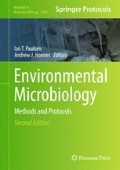Abstract
Single-cell Raman spectroscopy is a noninvasive and label-free technology for biochemical analysis of bacterial cells. A single-cell Raman spectrum functions as a metabolic “fingerprint” of an individual cell, which enables differentiation of cell types, physiological states, nutrient condition, and variable phenotypes. Raman tweezers combines single-cell Raman spectroscopy with optical laser tweezers to allow the identification and isolation of single living cells according to their Raman spectra. After cell sorting subsequent culturing and genomic sequencing has the potential to reveal totally new groups of microbes. Stable isotope probing with Raman tweezers offers a culture-independent toolbox to study genetic functions and physiology of unculturable microorganisms in the ecosystem.
Access this chapter
Tax calculation will be finalised at checkout
Purchases are for personal use only
References
Wagner M et al (1993) Probing activated-sludge with oligonucleotides specific for proteobacteria—inadequacy of culture-dependent methods for describing microbial community structure. Appl Environ Microbiol 59: 1520–1525
Riesenfeld CS et al (2004) Metagenomics: genomic analysis of microbial communities. Annu Rev Genet 38:525–552
Jones JG (1977) Effect of environmental-factors on estimated viable and total populations of planktonic bacteria in lakes and experimental enclosures. Freshwater Biol 7:67–91
Ferguson RL et al (1984) Response of marine bacterioplankton to differential filtration and confinement. Appl Environ Microbiol 47:49–55
Torsvik V et al (1990) High diversity in DNA of soil bacteria. Appl Environ Microbiol 56:782–787
Ellis RJ et al (2003) Cultivation-dependent and -independent approaches for determining bacterial diversity in heavy-metal-contaminated soil. Appl Environ Microbiol 69:3223–3230
Rappe MS, Giovannoni SJ (2003) The uncultured microbial majority. Annu Rev Microbiol 57:369–394
Huang WE et al (2010) Shining light on the microbial world: the application of Raman microspectroscopy. Adv Appl Microbiol 70: 153–186
Huang WE et al (2009) Resolving genetic functions within microbial populations: in situ analyses using rRNA and mRNA stable isotope probing coupled with single-cell Raman-fluorescence in situ hybridization. Appl Environ Microbiol 75:234–241
Huang WE et al (2004) Raman microscopic analysis of single microbial cells. Anal Chem 76:4452–4458
Huang WE et al (2007) Raman-FISH: combining stable-isotope Raman spectroscopy and fluorescence in situ hybridization for the single cell analysis of identity and function. Environ Microbiol 9:1878–1889
Huang WE et al (2009) Raman tweezers sorting of single microbial cells. Environ Microbiol Rep 1:44–49
Liberal ATD et al (2005) Contaminant yeast detection in industrial ethanol fermentation must by rDNA-PCR. Lett Appl Microbiol 40:19–23
Marchesi JR et al (1998) Design and evaluation of useful bacterium-specific PCR primers that amplify genes coding for bacterial 16S rRNA. Appl Environ Microbiol 64: 795–799
Huang WE et al (2005) Chromosomally located gene fusions constructed in Acinetobacter sp ADP1 for the detection of salicylate. Environ Microbiol 7:1339–1348
Delorenzo V et al (1990) Mini-Tn5 transposon derivatives for insertion mutagenesis, promoter probing, and chromosomal insertion of cloned DNA in gram-negative eubacteria. J Bacteriol 172:6568–6572
Acknowledgements
We thank Dr. Simon FitzGerald in HORIBA Scientific Ltd. for his technical input and helpful discussion. We are indebted to the Central Laser Facility at the Rutherford Appleton Laboratory for providing access to the instrument.
Author information
Authors and Affiliations
Editor information
Editors and Affiliations
Rights and permissions
Copyright information
© 2014 Springer Science+Business Media, LLC
About this protocol
Cite this protocol
Li, M., Boardman, D.G., Ward, A., Huang, W.E. (2014). Single-Cell Raman Sorting. In: Paulsen, I., Holmes, A. (eds) Environmental Microbiology. Methods in Molecular Biology, vol 1096. Humana Press, Totowa, NJ. https://doi.org/10.1007/978-1-62703-712-9_12
Download citation
DOI: https://doi.org/10.1007/978-1-62703-712-9_12
Published:
Publisher Name: Humana Press, Totowa, NJ
Print ISBN: 978-1-62703-711-2
Online ISBN: 978-1-62703-712-9
eBook Packages: Springer Protocols

